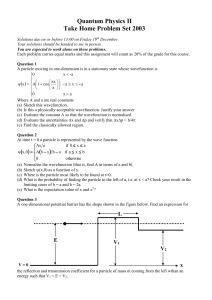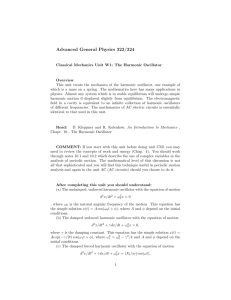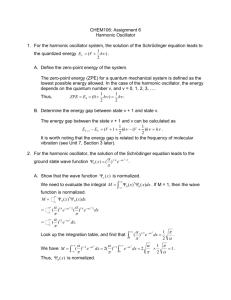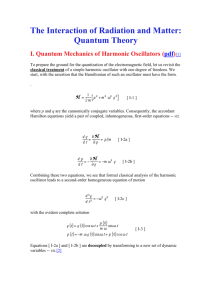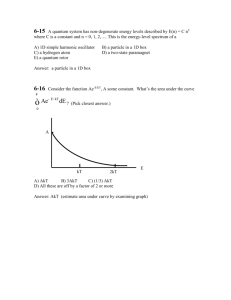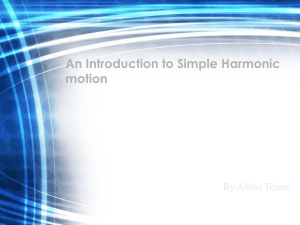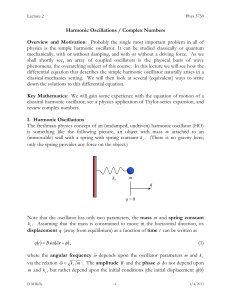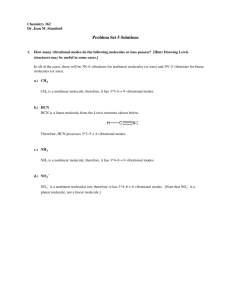ECE 779/879 Principles and Applications of Laser Engineering
advertisement
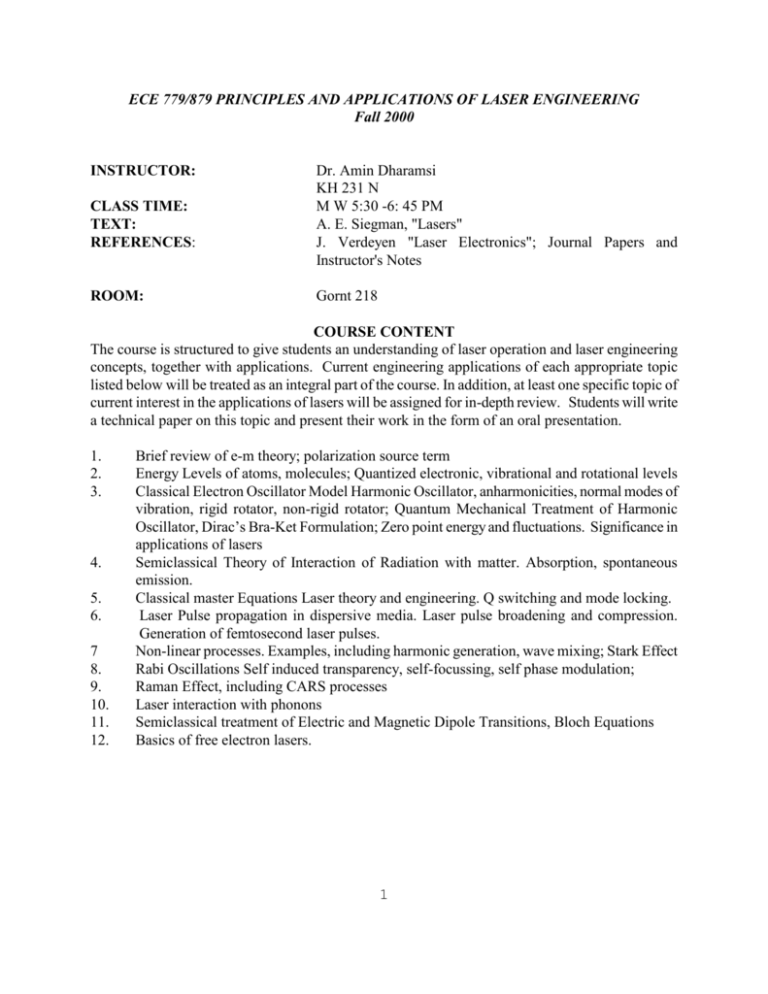
ECE 779/879 PRINCIPLES AND APPLICATIONS OF LASER ENGINEERING
Fall 2000
INSTRUCTOR:
CLASS TIME:
TEXT:
REFERENCES:
ROOM:
Dr. Amin Dharamsi
KH 231 N
M W 5:30 -6: 45 PM
A. E. Siegman, "Lasers"
J. Verdeyen "Laser Electronics"; Journal Papers and
Instructor's Notes
Gornt 218
COURSE CONTENT
The course is structured to give students an understanding of laser operation and laser engineering
concepts, together with applications. Current engineering applications of each appropriate topic
listed below will be treated as an integral part of the course. In addition, at least one specific topic of
current interest in the applications of lasers will be assigned for in-depth review. Students will write
a technical paper on this topic and present their work in the form of an oral presentation.
1.
2.
3.
4.
5.
6.
7
8.
9.
10.
11.
12.
Brief review of e-m theory; polarization source term
Energy Levels of atoms, molecules; Quantized electronic, vibrational and rotational levels
Classical Electron Oscillator Model Harmonic Oscillator, anharmonicities, normal modes of
vibration, rigid rotator, non-rigid rotator; Quantum Mechanical Treatment of Harmonic
Oscillator, Dirac’s Bra-Ket Formulation; Zero point energy and fluctuations. Significance in
applications of lasers
Semiclassical Theory of Interaction of Radiation with matter. Absorption, spontaneous
emission.
Classical master Equations Laser theory and engineering. Q switching and mode locking.
Laser Pulse propagation in dispersive media. Laser pulse broadening and compression.
Generation of femtosecond laser pulses.
Non-linear processes. Examples, including harmonic generation, wave mixing; Stark Effect
Rabi Oscillations Self induced transparency, self-focussing, self phase modulation;
Raman Effect, including CARS processes
Laser interaction with phonons
Semiclassical treatment of Electric and Magnetic Dipole Transitions, Bloch Equations
Basics of free electron lasers.
1
GRADING SCHEME
Term Paper
Written component
Oral presentations
Mid Term Exam (in class)
Final Exam (Take Home)
Due November 22(Wed)
Dec 4 (Mon), Dec 6(Wed)
October 11(Wed)
Due Dec 13
20%
15%
25%
40%
Term Paper Topic:
Choose one of the following topics to write on. Each paper should contain at least the points
outlined.
1. Bose-Einstein Condensation and Atom "Lasers"
Bosons and Fermions; Need for different statistical models; Bose-Einstein statistics, FermiDirac statistics (need for and differences between)
Bose-Einstein Condensation; "Coherent" atoms and molecules. Coherent phonons
Status of field
Current and possible future applications in engineering and science
2. Non-intrusive optical measurements of gaseous molecular species
Determination of species types, concentration, temperature and velocity
Simultaneous measurements of these parameters
Simultaneous measurements of multiple species
Sensitivity of measurements (smallest percentage changes that can be measured)
Applications in science and engineering (for example including but not restricted to pollution
monitoring, industrial combustion driven processes, chemical processes, atmospheric
sciences)
Term Paper Format:
Each term paper should be the work of the individual student, with proper references to journal
articles, books and other sources. References from the Internet need to be correlated to hard copy
published work in refereed journals, conference proceedings, and textbooks
The paper should not exceed 25, or be less than 10, single-spaced typed sheets (12 pt font should be
used), excluding reference list, figures, and 200 word required abstract.
All references should be given in the style that used in the Journal of Applied Physics.
Paper Presentation Format:
Each presentation should be done in Power Point and last between 20 and 25 minutes. There will be
approximately 10 minutes added to this time to allow for questions and answers.
2
First Semester 2000-2001 (Fall 2000)
August 28
Class begins (Monday)
September 2- 4 Labor Day Holiday (Sat-Mon)
October 24
Last day to withdraw from classes
(Tuesday)
November 22-26 Thanksgiving Holiday (Wed-Sun)
December 6
Class ends (Wed)
December 13
Take Home Final Exam Due (Wed)
3
ECE 779/879 Fall 2000 Some Suggested HW Problems from Siegman
1. Q1.4 p35
2. Q1.5 p 38
3. Q3 p 76
4. Q5 p 220
5. Q2 p241
6. Q2 p361
7. Q. 9.4.3
8. Q. 31.5.1
9. Q.26.2.5
-------------------------------------------------------------------------------------------------------------------------------
4
Additional HW Number1
Fall 2000
1.
Calculate the vibrational energy states for the CO molecule in the harmonic oscillator
approximation. Take the force constant to be k = 1.87 x 105 dynes/cm.
Using the Boltzmann distribution N (En) = No exp {-(En-Eo)/kT}, where N (En) is the density in
the level with energy En, and No is the density in the ground state, find the ratio of molecules in
the first vibrational state to that in the ground state.
What is the zero point energy?
What is the wavelength of a photon emitted in the 10 transition?
2.
If a+a/n> = n/n>, what are the eigenvalues of exp (a+a)?
3.
Given that a | E n > = n | E n-1 >, a + | E n > = n+ 1 | E n+1 >
and that
<EnEm> = nm, where n, m are integers.
Prove that:
(i) a + a | En > = n | En >
n!
n!
(ii) a m | E n > =
| E n-m > =
(a + )n-m | Eo >
(n- m)!
(n- m)!
(a + )n+m
(n+ m)!
(iii) (a ) | En > =
| Eo > =
| En+m >
n!
n!
+ m
4.
Given that
N e
| > = | E m >
m
m!
m
-N
1
2
1
exp - i(m+ )( t + )
2
show that:
(i) < | a + a | > = N
(ii) < | a + | > = N ei( t + )
(iii) < | a | > = N ei( t + )
5
ECE 779/879 Fall 2000 Additional HW #2
1.
With the help of the commutator [a, (a+) n], compute the commutator [a, ea+].
2.
It can be shown that an arbitrary ket vector may be denoted by giving its components along a
complete orthonormal set of basis vectors. We have also shown that each linear operator, to
which this vector may be subjected, can be represented by a matrix defined on the same basis
vectors. Recall:
n
= Aij a j
i =1
where > = isi> and Aij = <siAsj>.
Here A is the operator in question, si> are the basis vectors with <sisj> = ij (orthonormal set) and
n
|s
i
>< si | = I (complete set). The energy eigenkets En> of a harmonic oscillator form a complete
i =1
orthonormal set.
Hence, the Hamiltonian operator can be represented by a matrix
Hij = < Ei | H | E j > = < Ei | E j | E j > (since H | E j > = E j | E j >)
or,
1
Hij = E j < Ei | E j > = E j ij = Ei ij = i i +
2
Hence the matrix representation of the Hamiltonian of the harmonic oscillator is :
0
0
0....
1
H=
0
3
0
0....
2
0
5
0....
0
Notice H is diagonal. This illustrates the important result (which we have not proved) that an
operator has a diagonal representation when its own eigenkets constitute the basis.
Given all this, consider a diatomic molecule which is in a vibrational state comprising of the
1 -iEo t/
e | Eo > + e-iE1t/ | E1 >
| > =
2
ground and first excited states i.e.
6. Find the
expectation value of the energy, <E>. [Hint: <E> = <H>. Also treat the molecule as if
it has two and only two vibrational states, i.e. H becomes a 2 x 2 matrix. Interpret your answer
with a physical argument.
6
3.
We have seen that [a,a+] = 1 a+a = n, where a+ and a are the creation and annihilation operators.
We have seen how molecular vibrations can be represented as the motion of a harmonic
oscillator and how an e-m field may be regarded as a collection of infinitely many uncoupled
harmonic oscillators. "Particles" like the quanta of an e-m field (photons), elastic vibrational
quanta in crystals (phonons) and particles, among others are a group known as bosons. All
bosons abide by the algebra of the harmonic oscillator. There is another class of particles
known as fermions which include electrons, protons and neutrons. Fermions differ from
bosons in that no two fermions can occupy the same state. This is known as the Pauli
Exclusion Principle, which you have come across in the treatment of electronic energy levels.
Bosons are not subject to this restriction, as we know from our interpretation of En> for
photons as being the collection of n harmonic oscillators in the state characterized by n. In
this problem, you will develop the algebra of the fermion creation and annihilation operators, b+
and b.
These obey the following "anticommutation" relations
{b,b}+ = 0
;{b+,b+}+ = 0
(1a)
{b,b+}+ = 1
(1b)
where the anticommutator is
defined as {A,B}_AB + BA
b+b_N
(2)
(3)
(i)
(ii)
b2 = b+2 = 0
N2 = N
(a)
Show that
(b)
Given Nn> = nn>, prove that the only possible values of the eigenvalues n are n=1
and n=0. Note this means that only two states are possible for fermions, namely 1>
and 0> corresponding to n=1 and n=0 respectively. If N is interpreted as the number
operator, how can this result be connected to the Pauli exclusion principle?
(c)
Assuming that the kets 0>, 1> constitute a complete, orthonormal set, show that the
matrix representation of the operator N in this basis is
0
N=
0
7
0
1
ECE 779/879
Fall 2000
Additional Homework #3
1.
l3 nl
d
(2 )3 c2
We have shown
is the intensity (Joulesm2) of
radiation in the elemental solid angle d.
I o ( l )=
(a)
By integrating this, show that the total intensity of
radiation for an isotropic source of two polarizations
2
3
is I o = ( n l )/( c ) Joules(meter)2 where n 8is the average
number of quanta emitted.
(b)
We have proved
P abs =
3
o 2 | xab|2
e
l I o ( l ) = l W abs
o
and
P spon =
l4 2 | 2 o =
e x ab|
l W spon .
3 c 2
o
Calculate the ratio Wabs to Wspon, for the intensity Io in
(a).
2.
If a set of two level atoms with energies Ea and Eb are in
thermal equilibrium at temperature T, the number of atoms in
state a> is proportional to
exp(-Ea/kT) and for state b> the number is proportional to
exp(-Eb/kT), where k is the Boltzmann constant. Show that, if
the atoms are in thermal equilibrium with a radiation field,
the average number of quanta is given by the Planck
distribution law
-1
n = exp
- 1 where = E a - E b
kT
Hint:
3.
(a)
Use result of prob. 1.
For a Fabry-Perot etalon, maximum transmission occurs when
8
2nl cos
o
=m
(1)
Considering the case of normal incidence (=0o) prove that
df
- dl
=
f ( o /2n)
(2)
where f is the free spectral range, i.e.
co
2nl cos
(3)
(1 - R )2
It =
2
I i (1 - R ) + 4R Sin 2 /2
(4)
f = f m+1 - f m =
(b)
We have also shown that
f1
2 16
Using this show that if
is the frequency separation
between two frequencies at which the transmission is down to
half its peak value then
1 - 2n
Sin 2
2
2
(1 - R )2
=
4R
(5)
1/2 is the value of corresponding to the half power points.
(c)
Assuming
f 1=
2
co
1 - 2m
2nl cos 2
(6)
show
f1_
2
1- R
co
2nl cos R
(7)
f
co
=
F 2nl cosF
(8)
i.e. show
f 1=
2
9
10
